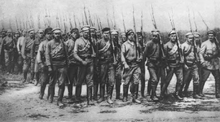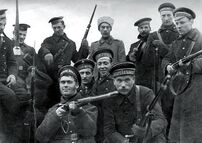- One or more subjects within this article are under rework, and may no longer be accurate.
The Russian Soviet Federative Socialist Republic (RSFSR), also known as Soviet Russia, was a Marxist-Leninist, revolutionary state which fought against the counter-revolutionary White Army for control of Russia during the Russian Civil War. Founded and organized around the Bolshevik (Majority) faction of the Russian Social Democratic Labour Party, they would later re-label themselves as the first Communist state in the world, and the vanguard of the global revolution.
Despite the crippling assassination of the Revolution's chief architect, Vladimir Lenin, at the hands of a Left SR terrorist in August 1918, the RSFSR managed to endure until the beginning of 1920, when it finally capitulated to the Whites following their successful storming of Moscow. In the aftermath of their defeat, many Soviet leaders were captured by the victorious Whites, fled into exile abroad, or simply disappeared, as in the case of the infamous Leon Trotsky.
The collapse of the Bolsheviks had tremendous repercussions for left-wing politics across the globe, namely through the discrediting of Bolshevism. The success of the later syndicalist revolutions in France and the former United Kingdom eventually pushed Bolshevism into obscurity as it became the ideology of fringe groups in various nations.
History[]
- Main article: Russian Civil War
Politics[]
The Soviet Russian government was defined by two key organs, the executive "Council of People's Commissars" (SOVNARKOM) and the legislative "Congress of Soviets."
While the latter had a significant non-Bolshevik representation in its early stages, the Left SR Uprising and the assassination of Lenin led to a precipitous drop in dissenting opinion, and by the last months of 1918, it was essentially an all-Bolshevik body.

Members of the SOVNARKOM meeting in early 1918.
| People's Commissar | Incumbent |
|---|---|
| Chairman | Vladimir Lenin (1917- Sep. 1st, 1918)
Lev Kamenev (Sep. 1st, 1918 - 1920) |
| Secretary | Nikolai Gorbunov |
| Agriculture | Vladimir Milyutin |
| War & Navy Affairs | Nikolai Krylenko (War)
Pavel Dybenko (Navy) |
| Trade & Industry | Viktor Nogin |
| Education | Anatoly Lunacharsky |
| Food | Ivan Teodorovich |
| Foreign Affairs | Leon Trotsky |
| Internal Affairs | Alexei Rykov |
| Justice | Georgy Oppokov |
| Labour | Alexander Shlyapnikov |
| Nationalities | Ioseb Dzhugashvili |
| Post & Telegraphs | Nikolai Glebov-Avilov |
| Finance | Ivan Skvortsov-Stepanov |
| Social Welfare | Alexandra Kollontai |
Military[]
Red Guards[]
Owing to their origins as a revolutionary, egalitarian movement, the Bolsheviks' first military units were largely informal militia units. Interspersed within this were more elite formations, like the Latvian Riflemen and Red Sailors, who ended up shouldering the burden of most of the fighting done in the skirmishes of the first months of Soviet rule.

A column of Red Guards in Petrograd, 1917.
Red Guard units continued the tradition of soldiers' soviets inherited from the Provisional Government's army, and as such had the authority to elect their own commanders and vote on their orders. This, predictably, had disastrous effects on combat effectiveness, but its elimination was spotty over the course of 1918. The Red Guards were also drawn overwhelmingly from the urban proletariat, which severely hampered their effectiveness in operating beyond the cities in which they were raised.
As the Red Army became increasingly professional and disciplined, the Red Guards were largely relegated to the status of reserves and garrisons.
Red Army[]
Though the Workers' and Peasants' Red Army was formally founded in January 1918, it would take nearly half a year for it to become a viable fighting force. Drawn initially from the best of the Red Guards, the enacting of conscription in June 1918 dramatically swelled the Red Army's ranks, to the point that it exponentially outnumbered the Whites, at least on paper. This coincided with a dramatic increase of fighting effectiveness in the wake of reforms decreed by SOVNARKOM.

Red Army men on the march to Kharkov (1919).
At the behest of Trotsky, the Red Army largely did away with the democratic and egalitarian nature of the older Red Guards. Red "commanders" were officers in all but name, and desertion, dereliction of duty, and "counter-revolutionary agitation" could all be punished by death at the hands of integral Cheka detachments and political commissars. Many of these measures were spearheaded in the aftermath of Lenin's assassination, which saw the Cheka and its leader, Felix Dzerzhinsky, become one of the most influential elements of the Soviet regime.

A Red Army unit of Chinese volunteers. "Internationalist" units like these were a much-lauded element of the Red Army, regardless of their actual size.
Trotsky likewise advocated for the forced enlistment of ex-Tsarist officers into the Red Army as a means of buffering the Bolsheviks' crippling lack of experienced commanders. The measure was met with serious criticism from other members of the SOVNAKROM, but it was nevertheless accepted and proved quite successful, at least early on. In the war's final months, the weakening of the Cheka's grip meant that these coerced officers were often the first to desert, with serious consequences, as these deserters often took their troops and valuable intelligence with them. In the Civil War's aftermath, it was this act which became one of the greatest black marks levied on Trotsky by leftist analysts and historians.

Red cavalry enters a captured town on the Volga front (February, 1919).
Nevertheless, the Red Army performed reasonably well for much of the war's duration, only truly disintegrating after the devastating, consecutive defeats on the Volga, Kharkov, and Petrograd in the later months of 1919. However, the real death-knell of the Red Army was the endemic starvation and desertion which characterized the last months of Soviet power. Disillusionment with the increasing brutality of the Bolsheviks led to a dramatic loss of faith among the lower ranks, many of whom saw the large SR bloc in the White Provisional All-Russian Government as the more legitimate representative of the people.
[]
Owing to the largely land-locked nature of most of the fighting in the Civil War, the vessels of Workers' and Peasants' Red Fleet played a negligible role. By contrast, the Red Fleet's sailors formed a core element of the Red Army and often served as highly-motivated shock troops in the same vein as the White "Officer" units.

A fighting detachment of Red Sailors (1917).
However, the strong anarchist and Left SR undercurrent present in many naval units was one of the key elements in the fall of Petrograd to the Whites, as the Kronstadt garrison and Red Fleet mutinied against Grigory Zinoviev's orders to sally out of the city to save Trotsky's doomed relief column.
Air Force[]
The Workers' and Peasants' Red Air Fleet not only inherited much of the stock of aircraft left over from the Tsarist and Republican regimes but also many of the aircraft factories, which gave them a definite advantage in air superiority over the Whites in the early period of the Civil War.
This advantage began to gradually dissipate as more and more German aircraft were supplied to the Whites, with the decisive turning point begin the recognition of the PA-RG by the Central Powers in June 1919. Red manufacturing not only failed to keep pace, but the machines being supplied to the Whites were typically more advanced than the aging French designs used by the Bolsheviks.
Foreign relations[]
WIP
Economy[]
WIP
Culture[]
WIP
